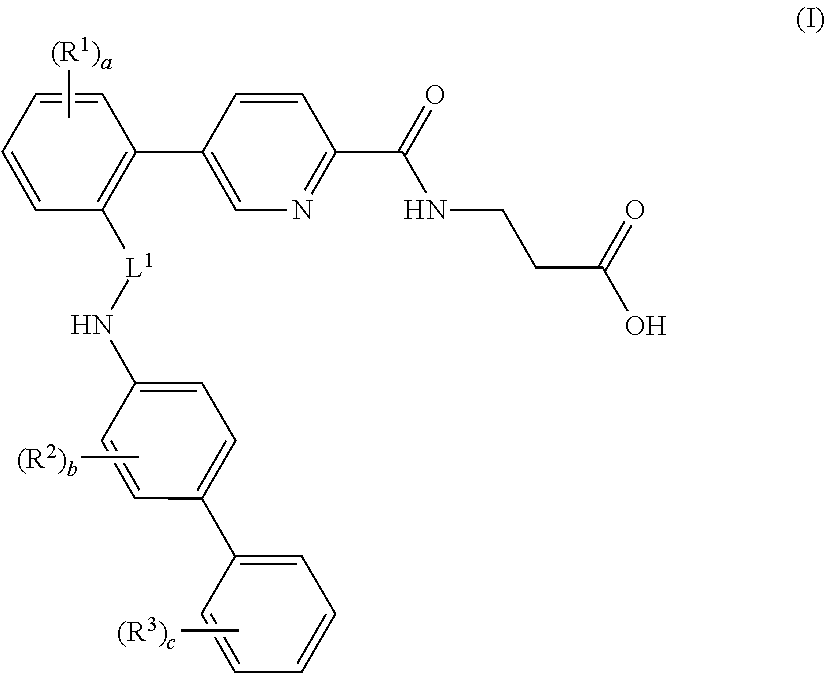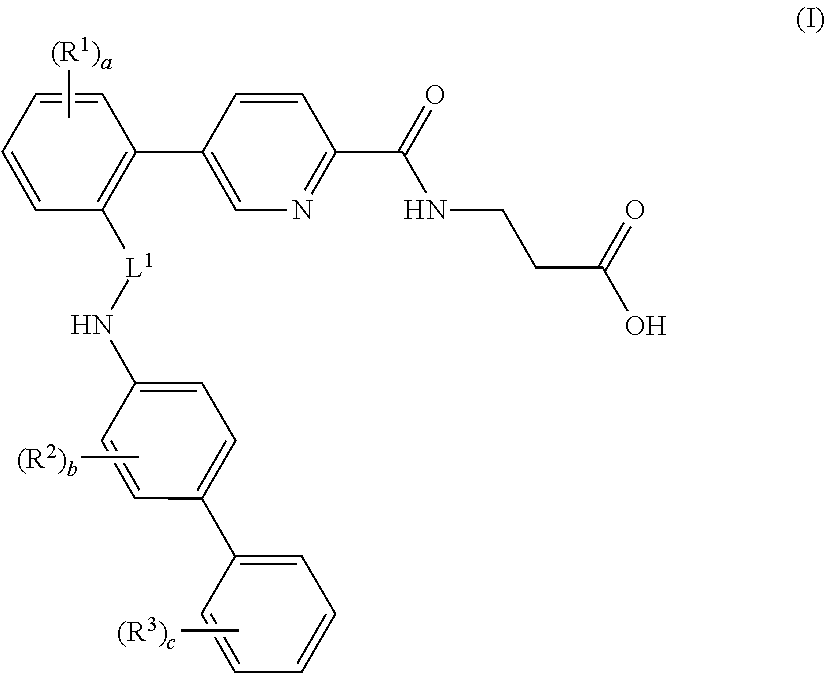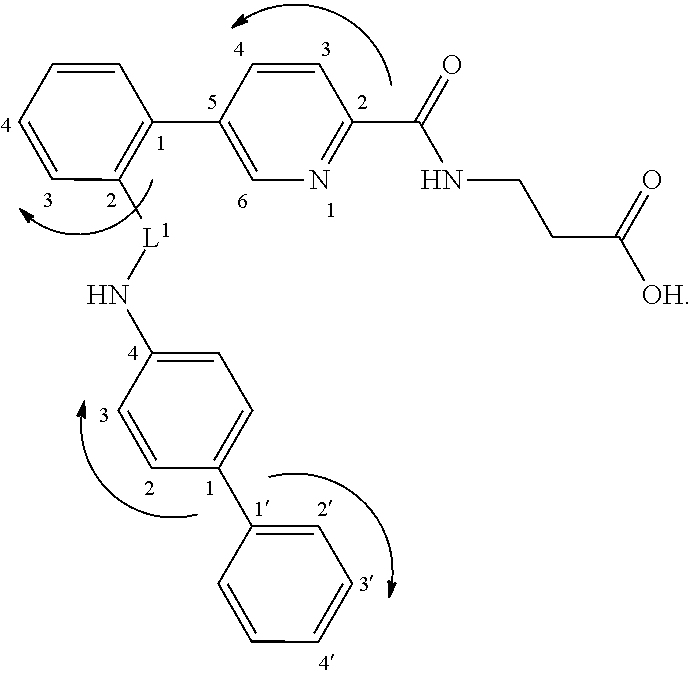Picolinamido-propanoic acid derivatives useful as glucagon receptor antagonists
a technology of glucagon receptor and derivatives, which is applied in the field ofpicolanmidopropanoic acid derivatives, can solve the problems of increased endogenous glucose production, hyperglycemia during the postabsortive and postprandial states, and decreased glucose disposal
- Summary
- Abstract
- Description
- Claims
- Application Information
AI Technical Summary
Benefits of technology
Problems solved by technology
Method used
Image
Examples
synthesis examples
[0159]The following Examples are set forth to aid in the understanding of the invention, and are not intended and should not be construed to limit in any way the invention set forth in the claims which follow thereafter. In the examples which follow herein, the Example number corresponds to the Compound (ID) number, as listed in Table 1, above.
[0160]In the Examples which follow, some synthesis products are listed as having been isolated as a residue. It will be understood by one of ordinary skill in the art that the term “residue” does not limit the physical state in which the product was isolated and may include, for example, a solid, an oil, a foam, a gum, a syrup, and the like.
example 1
3-(5-(2-(([1,1′-biphenyl]-4-ylamino)methyl)phenyl)picolinamido)propanoic acid
[0161]
STEP A: Ethyl 3-(5-bromopicolinamido)propanoate
[0162]Solid HATU (3.8 g, 9.9 mmol) was added to a THF solution (100 mL) of 5-bromopicolinic acid (2.0 g, 9.9 mmol), i-Pr2NEt (5.2 mL, 29.7 mmol), and (3-alanine ethyl ester hydrochloride (1.7 g, 10.9) and the resulting mixture was warmed to 45° C. After 16 h the resulting mixture was diluted with EtOAc, washed with water and brine, dried (Na2SO4), concentrated and purified via column chromatography to yield the title compound.
STEP B: Ethyl 3-(5-(2-formylphenyl)picolinamido)propanoate
[0163]Ethyl 3-(5-bromopicolinamido)propanoate (800 mg, 2.7 mmol), 2-formylphenylboronic acid (518 mg, 3.5 mmol), Pd(dppf)Cl2 (217 mg, 0.27 mmol), and K2CO3 (734 mg, 5.3 mmol) were dissolved in 1,4-dioxane (16 mL) and water (4 mL) and heated to 80° C. After 3 h the resulting mixture was cooled to room temperature, diluted with EtOAc washed with water and brine, dried (Na2SO4), ...
example 2
3-(5-(2-(((4′-chloro-[1,1′-biphenyl]-4-yl)amino)methyl)phenyl)picolinamido)propanoic acid
[0167]
STEP A: tert-butyl 3-(5-bromopicolinamido)propanoate
[0168]Solid HATU (4.0 g, 10.6 mmol) was added to a THF solution (100 mL) of 5-bromopicolinic acid (2.1 g, 10.6 mmol), i-Pr2NEt (7.4 mL, 42.4 mmol), and (3-alanine t-butyl ester hydrochloride (2.1 g, 11.7) and the resulting mixture was warmed to 45° C. After 16 h the resulting mixture was diluted with EtOAc, washed with water and brine, dried (Na2SO4), concentrated and purified via column chromatography to yield the title compound.
STEP B: tert-butyl 3-(5-(2-formylphenyl)picolinamido)propanoate
[0169]tert-Butyl 3-(5-bromopicolinamido)propanoate (1.0 g, 3.0 mmol), 2-formylphenylboronic acid (547 mg, 3.6 mmol), Pd(dppf)Cl2 (249 mg, 0.3 mmol), and K2CO3 (840 mg, 6.1 mmol) were dissolved in 1,4-dioxane (20 mL) and water (5 mL) and heated to 80° C. After 3 h the resulting mixture was cooled to room temperature, diluted with EtOAc washed with wate...
PUM
| Property | Measurement | Unit |
|---|---|---|
| Composition | aaaaa | aaaaa |
Abstract
Description
Claims
Application Information
 Login to View More
Login to View More - R&D
- Intellectual Property
- Life Sciences
- Materials
- Tech Scout
- Unparalleled Data Quality
- Higher Quality Content
- 60% Fewer Hallucinations
Browse by: Latest US Patents, China's latest patents, Technical Efficacy Thesaurus, Application Domain, Technology Topic, Popular Technical Reports.
© 2025 PatSnap. All rights reserved.Legal|Privacy policy|Modern Slavery Act Transparency Statement|Sitemap|About US| Contact US: help@patsnap.com



